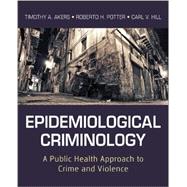
Note: Supplemental materials are not guaranteed with Rental or Used book purchases.
Purchase Benefits
What is included with this book?
Timothy A. Akers, M.S., Ph.D., is a professor of public health and associate dean for graduate studies and research in the School of Computer, Mathematical and Natural Sciences and director of the Center for Health Informatics, Planning and Policy at Morgan State University in Baltimore, Maryland.?
Roberto H. Potter, Ph.D., is the director of research partnerships at the Department of Criminal Justice, College of Health and Public Affairs at the University of Central Florida.
Carl V. Hill, M.P.H, Ph.D., is a health scientist administrator and contract officer's representative with the National Institutes of Health, Eunice Kennedy Shriver National Institute of Child Health and Human Development.?
Figures and Tables
Preface
Acknowledgments
The Authors
Introduction: Crime, Criminal Justice, Health, and Victims
Levels of Theoretical Analysis
Why the Meso Is Important
Revising the Epidemiological Trinity
Hosts, Agents, Agency, and Behavior
Risk, Deviance, Crime, and Health
Summary
Part One: Foundation for an Emerging Paradigm: Epidemiological Criminology
1 Establishing a Historical Framework for Epidemiological Criminology
The War on Poverty
The War on Crime
The War on Drugs
The War on Terror
Conclusion
Summary
2 Where Two Worlds Collide: Toward an Integrated Theory of Epidemiological Criminology
Roots and Forks in the Road
History
Determining When or Where to Start an Investigation
Defining an Emerging Paradigm
Epidemiological Criminology
Conclusion
Summary
3 The Lexicon of Terminology: Developing an Emerging Paradigm
Scientific and Practice Integration: Building a Emerging Paradigm
Theories and Models: An Integrative Paradigm
Units of Analysis
Health and Crime: Biomedical and Behavioral Disparities
Prevention Interventions
Causation: The Epidemiologic Triad
Conclusion
Summary
Part Two: Theories, Concepts, and Methods
4 Criminology, Criminal Justice, and the Social Sciences Criminology
Criminal Justice
Where Does That Leave Epidemiological Criminology?
Public Health
Lessons from the Foundation of Sociology
Conclusion
Summary
5 Research Methods in Epidemiology and Criminology: A Bridge Between?
Surveillance or Monitoring?
Monitoring, Surveillance, and Epidemiological Criminology
Method, Technique, and Theory
The Evidence Base
In the Field and on the Streets
Conclusion
Summary
6 Integrating the Interdisciplinary Sciences: Theoretical Foundations of the Epidemiological Criminology Framework
Criminogenics: The Evidence Base of Individual Criminal Behavior
Propensity Versus Typology: How Changeable Are Criminogenics?
Dynamic Risks
Implications for Public Health Interventions
Social Learning and Social Structure: Moving Evidence to the Next Social Levels
Epidemiological Criminology Implications for Public Health Interventions
Conclusion
Summary
Part Three: Applying Epidemiological Criminology in Practice and Policy
7 Health Disparities and Epidemiological Criminology
Health Disparities
Conceptualizing Criminological Disparities
Conceptualizing Epidemiological Criminology and Disparities
Conclusion
Summary
8 Incarceration and Epidemiological Criminology
The Organizational Ecology of Incarceration
Incarceration by Police
Juvenile Detention: A Snapshot
The Process of Incarceration
The Epidemiology of Incarceration: The Importance of Process
Criminal Records
Conclusion
Summary
9 The Health of Correctional Populations
Competing Images: Magic Castles and Houses of Horror
Juvenile Detention
Jail
Health of Jail Inmates
Health of Prisoners
HIV: An Exemplar of Where One Looks and How
Reentry to the Community
Implications for Epidemiological Criminology
Conclusion
Summary
10 Recidivism and Epidemiological Criminology
Why Measure Recidivism?
Defining and Measuring Recidivism
How Much Recidivism?
Who Returns to Prison?
Jails and Recidivism
Health Recidivism
Conclusion
Summary
11 Gang Violence and Adolescent Membership
Biopsychosocial and Environmental Determinants
Micro-, Meso-, and Macroinfluences
Epidemiology of Gangs and Gang Violence
An Integrated Approach
Health Behavior and Criminal Behavior
Biomedical Disparities and Behavioral Disparities
Conclusion
Summary
12 Criminality, Substance Abuse, and Mental Health: An Epidemiological Criminology Framework
Criminalization
Mental Illness, Crime, and Criminal Justice
Mental Illness and Epidemiological Criminology
Substance Abuse
Substance Abuse and Epidemiological Criminology
Conclusion
Summary
13 Victims and Victimization
Victims and Victimology
The Academy Discovers Victims
The Role of Place: Geography and Victimization
Routine Activities
The Health Industrial Complex Discovers Victims
Measuring Victims
Violence and Epidemiological Criminology
Conclusion
Summary
Part Four: Future Direction and Trends
14 Environmental Justice and the Epidemiology of Crime
What Is Environment? What Is Justice?
The Traditional Epidemiological Approach: What Is Missing?
Segregation and Health
Residential Segregation and Criminal Behavior
Environmental Justice and Epidemiological Criminology
Conclusion
Summary
15 Global and Domestic Terrorism
Epidemiology of Terrorism
Epidemiological Criminology as an Integrated Paradigm
Biopsychosocial and Environmental Makeup of Terrorism and Terrorists
Micro-, Meso-, and Macroinfluences
Health Behavior and Criminal Behavior
Biomedical Disparities and Behavioral Disparities
Conclusion
Summary
16 Criminal Law, Public Health Law, and the Epidemiological Criminology Framework
Criminal Law, Public Health Law, and Social Control
Whose Interests?
Law and Epidemiological Criminology
Values
Conclusion
Summary
17 International Human Rights and Human Trafficking
What Is a Right?
Does the Epidemiological Criminology Framework Fit Human Rights?
A General Model of Trafficking
Trafficking Networks
Individual Traffickers and Individual Victims
Responding to Human Trafficking from an Epidemiological Criminology Framework
Conclusion
Summary
References
Further Reading
Index
The New copy of this book will include any supplemental materials advertised. Please check the title of the book to determine if it should include any access cards, study guides, lab manuals, CDs, etc.
The Used, Rental and eBook copies of this book are not guaranteed to include any supplemental materials. Typically, only the book itself is included. This is true even if the title states it includes any access cards, study guides, lab manuals, CDs, etc.